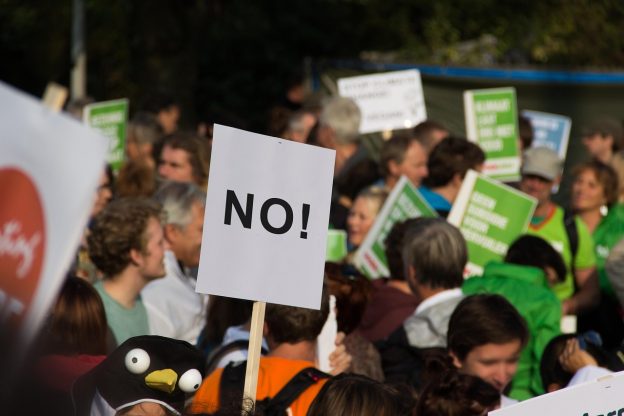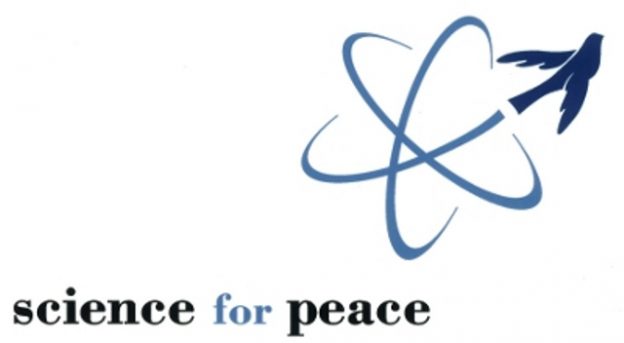“What’s our life and freedom worth
When a tyrant seeks our earth,
Aiming to subdue our land with greedy hands?
But we’ll stand against his might
Canada won’t yield this fight
And we’ll shout across our free and sovereign land:
Go home, Yankee! Yankee go home!
Keep your deals and go back home.”
“Yankee, Go Home” is just one of several Canadian anti-Trump songs circulating among Canadians. Trump’s threats against Canada – 25% across-the-board tariffs, repeated demands to make Canada the 51st state, and disrespectful references to our prime minister as “Governor Trudeau” – prompted this patriotic outpouring.
Although it is unlikely – indeed unthinkable – that Trump will invade Canada, we live in an increasingly unstable world. We can minimize the risk of external intervention to the extent we remain a united country and one with many organizations skilled in the practice of nonviolent resistance. We cannot match the United States in military power. But we can learn to paralyze military might through nonviolent resistance. In addition, familiarity with these techniques empowers citizens to preserve a vibrant democracy. Civil resistance is equally efficacious in defeating would-be tyrants. In the turbulent times to come, we should be prepared.
We Canadians are learning that freedom is not free, when you live next to a superpower that can turn on you in a moment. US proclamations of support for universal human rights, national sovereignty, and a rules-based international order can vanish with a change of regime. These ideals, though admittedly tarnished by the historical actions of the United States, have now been replaced by the predatory, amoral dictum of might makes right.
Yet we are not defenceless. Nonviolent resistance can work as a spontaneous response, though it is more effective with prior training and with a culture of civilian-based unarmed resistance. This culture does not exist in Canada (as it does in India, for example). We have been distracted from the efficacy of this strategy by the dominant narrative that national security depends on military strength alone. The emergency we now face, in middle-power Canada, reminds us how important it is that this notion of security be reframed.
Why is Canada a target?
Canadians from coast to coast to coast have reacted with anger and defiance to Trump’s bullying behaviour. All of Trump’s charges against Canada are baseless:
- Trade deficit? Trump has claimed a trade deficit with Canada of US$200 -$250 billion, but according to US statistics, the deficit was US$55 billion in 2024. If you factor in trade in services, the deficit falls to US$45 billion. If you exclude energy exports from Canada, which are sold at a discount from international prices, the US has a healthy trade surplus with Canada.
- A conduit for drugs and undocumented migrants to the US? Trump wants to penalize Canada with exorbitant tariffs for permitting an “invasion” from the North, but US government studies show that infinitesimal proportions of total migrants and fentanyl reach the US across the northern border.
- US banks cannot operate in Canada? Many US banks operate in Canada, constituting about half of all foreign banking assets.
Why the lies and threats? The key is politics, not economics. Trump mobilizes his followers with the rhetoric of making America great again. The narrative is that the US has been victimized by both external and internal enemies. The role of the leader is to defeat these enemies and affirm his, and his country’s, greatness. Canada is now one of these purported external enemies, along with Mexico, China, and even NATO. Thus, Canada must be prevented from (purportedly) victimizing the American people. Moreover, another way to make American great again is to absorb or at least dominate other countries. Canada is a tempting target for domination with its bounty of natural resources, fresh water, and “nice” (pliable?) people.
Canada is not the only foreign territory under threat from Trump. The list now includes Greenland, the Panama-canal zone, and Gaza. Countries with small and medium populations must look to their own defence, as international norms decay.
A major weapon of the weak but resolute is nonviolent resistance.
What is Nonviolent Resistance?
Nonviolent resistance is not only a more effective defence than military force, but also less devastating in terms of lives lost and property destroyed. Indeed, the songs I’ve mentioned are actually one dimension of nonviolent resistance. They warn a potential aggressor that there will be no easy victory, while fostering a unity of purpose in the targeted national population.
To respond to an actual or threatened invasion with military force would be foolhardy. Canada would experience widespread casualties and the destruction of our largest cities. An armed insurrection would be more effective, in light of Canada’s vast territory and numerous mountains and forested areas. But the recourse to deadly force would lead not only to widespread casualties, but also to making enemies of US soldiers who, in the main, would initially sympathize with their friendly neighbours. The goal is to win over the occupying force, not drive it, through fear, to retaliation and hatred.
The answer to the conundrum of how to defeat aggression with the least damage is nonviolent resistance. This strategic concept emerged in the 1980s and 1990s at the height of the Cold War. An early proponent was the American Gene Sharp, supported by the Albert Einstein Institution. Sharp is often referred to as the “Clausewitz of non-violent warfare.” Recent major contributors on civilian resistance –Srdja Popovic, Erica Chenoworth and Michael Beer – follow in Sharp’s footsteps.
Nonviolent resistance involves using a country’s population and its institutions to deter an invasion, and if that fails, to defeat and drive out the invaders. A determined people deter an aggressor by signally that the targeted country is united in opposition to a take-over. The government and people need to appear fully committed to defending themselves. They will do so by making their society “unrulable” by the would-be aggressor.
The invader cannot consolidate its political control if the subject people and the institutions refuse to comply with its rule. The tactics involve, in the first instance, total noncooperation with the occupying force, together with open defiance. That means that governments at all levels in the invaded nation would continue to supply only the basic services that a modern society requires for its survival: clean water, electricity, sanitation, policing, fire control, etc. Governments would resign, and civil servants would find ways to subvert every order issued by the invader. Crowds would fill the squares in silent or derisory defiance of orders. No violent response must be the norm: it should be apparent to all – the occupiers, the dictator’s audience back home, less committed Canadians, and foreign observers – who are the purveyors of violence against nonviolent people, and who simply want to live peacefully in their own homeland.
Throughout the occupation, citizens and organizations focus on subverting the loyalty and morale of the occupying troops and functionaries and rallying international support against the invader. In Canada’s case, the long history of friendship with Americans will mean that the morale of the occupiers is low. The aim is to encourage defections and desertions by talking face-to-face with soldiers and functionaries. If these tactics are effective, the support base of the external dictator begins to erode, both within the armed forces and among the Americans at home. This erosion of support may lead to the overthrow of the leader, or at least to his willingness to concoct some compromise to cover a retreat.
Attracting international support to Canada’s cause should not be a challenge. Trump alienated most of humankind and foreign governments during his first month in office.
Nonviolent resistance is just refined common sense. For a middle power like Canada, national security depends as much on our unity, our determination, and our understanding of the basic principles of nonviolent defence as on military power.
Canada is an ideal candidate for this strategy vis-à-vis the United States. We cannot match the US in firepower or economic strength. However, Canada shares with America a language, a history of common struggles, a myriad of cross-border personal relationships, and basic democratic values (at least with the majority). These factors give Canada considerable leverage. Although it is unlikely that Trump will invade Canada, a united country capable of nonviolent resistance decreases the risk. In any event, these tactics have a relevance beyond deterring invasion: they empower the people to preserve a strong democracy.
Cases of Nonviolent Resistance
Civilian defence is not merely a theory. Not only is there a long history of improvised civilian resistance to invasions, but also countries such as Sweden, Switzerland, Finland and Lithuania have institutionalized civilian defence at various times.
Sharp identifies 16 examples in his 1990 book on civilian-based defense. These cases involve anti-colonial struggles (4), revolts against Communist rule (4), struggle against domination by a powerful neighbour (2) – including the brave Danish resistance to occupation during World War II, and resistance to internal oppression/human-rights violations (6). The degree of effective struggle varies widely; some failed while others succeeded (for example, the Gandhian movement in India).
Srdja Popovic’s Blueprint for Revolution offers more recent examples of nonviolent resistance, mostly to defeat internal usurpers. He also updates Sharp’s strategy and tactics, especially for youth in the digital age. He includes an entertaining section on “laughtivism.” Popovic and his colleagues now coach resistance movements worldwide on the strategy and tactics of nonviolence. How much more effective might Sharp’s exemplary resistance movements have been if they had the benefit of this accumulated wisdom? Instead, the resisters had to invent nonviolence in the moment.
Another exemplary case is Ukraine. Ukrainians, when Russia invaded their country in February 2022, undertook many spontaneous and inspirational acts of nonviolent resistance. Civilians blocked tanks and convoys, berated or cajoled Russian soldiers to undermine their resolve, gave wrong directions to Russian convoys, refused to cooperate, and mounted spontaneous protests in occupied towns. But then the bloody carnage on both sides overwhelmed civilian defense.
Consider how more effective Ukraine’s nonviolent defense would have been if it had been planned and Ukrainians trained in non-violent methods. With a civilian defense system in place, the Ukrainian armed forces might have allowed the Russian tanks to enter the country unimpeded. No immediate deaths, no destruction. But what can you, the invader, do with tanks when you face a population united in defiance, unarmed protest and complete non-cooperation? Ukraine might have made itself ungovernable by an occupier.
In addition to the more spontaneous incidents, certain countries have institutionalized civilian defence for varying lengths of time. Consider Sweden: “Total defence” (military plus civilian defence) originated in neutral Sweden in the dangerous 1930s and World War II. Created in 1944, a Swedish Civil Defence Board undertook research on civil defence, organized training and oversaw the construction of air raid shelters. Sweden ran civilian-defence training centres in six cities during the Cold War. In 1986 the agency merged with the fire services board in a new Rescue Services Agency. The end of the Cold War led to a withering of the civil defence component. The initial idea – that all citizens had a duty to protect their country in an organized manner – fell into disuse by the mid 1990s.
The Russian attack on Georgia and seizure of Crimea, however, revived the concept of total defence after 2014. Everyone between the age of 16 and 70 again had an obligation to respond in the event of an invasion or a natural catastrophe. “Everyone is obliged to contribute and everyone is needed” proclaimed a government pamphlet in 2018. Swedes were cautioned in the same pamphlet to prepare themselves for an emergency, though the emphasis was as much on peace-time natural emergencies as war. Nevertheless, in the event of war, the pamphlet declared that “we will never give up”. This basic idea is central to nonviolent resistance: an invader may occupy territory, but total non-cooperation and symbolic opposition will raise the costs of occupation, thereby discouraging invasion in the first place. In principle, all municipalities, voluntary organizations, businesses, trade unions, and religious organizations are required to prepare for civilian defence.
By March 2022, at the height of the war in Ukraine, one in three Swedes was fairly or very concerned their country would be attacked. Furthermore, a 2021 survey registered popular support for the idea of civil defence: 84 percent of Swedes said they would be willing to play a defence role, so long as it was non-combative.
Sweden is not relying on civilian defence, of course. Following Russia’s invasion of Ukraine in 2022, the government raised the defence budget and joined NATO. But the idea of civil defence persists as a defiant complement, to military defence.
Obstacles
Nonviolent resistance is more effective if it is nationally organized and if training is available throughout society. But partisan divides and apathy make such country-wide organization and training improbable in Canada.
Sharp, in Civilian-Based Defense contends that nonviolent defence, to succeed, must adhere to an “all-of-society,” nonpartisan approach. People of both sexes and all ages must participate, according to Sharp. They will do so out of patriotism, the desire to maintain their way of life, and an abhorrence of domestic and foreign usurpers alike. Nonviolent defence is more likely to work where social cohesion is high and democracy and civil society are strong.
However, is this “all-of-society” scenario realistic in today’s world? Most countries, including Canada’s, are riven with partisan divides. Consequently, organization and training for nonviolent resistance, whether organized by the government or voluntary associations, would be viewed with suspicion by right-wing/populist forces as a leftist plot. Conspiracy theories might abound.
Another problem is that alienation and cynicism are rife in Western societies today. What will induce people to devote their free time to training in nonviolence? Motivation is a problem, magnified by partisan divides.
These considerations suggest that a top-down, apolitical organization and training in civilian defense will not work. Nonetheless, training and organization should be the goal of as many organizations as possible within civil society: churches, synagogues, temples, civil rights organizations, unions, indigenous rights organizations, peace organizations, climate groups, for example. Michael Beer’s manual on more than 300 tactics of nonviolent resistance, which is available free online, is an accessible guide. Widespread training and organization are the road not only for deterring aggression, but also remaining free of tyrants.
Conclusion
Countries bordering on a Great Power, such as Canada, can benefit from nonviolent defense. These countries could not hope to defeat an invading force from the superpower – or at least not without inflicting enormous damage and casualties upon themselves. Besides training as many as possible in the methods of nonviolent defence, civil society organizations would build strong links with peace groups internationally and with sympathetic groups within the superpower. The aim would be to precipitate internal dissent in the aggressor’s country and international condemnation of the invader, possibly including sanctions, in the event of a conflict. This strategy would proceed along with a willingness to negotiate to resolve conflicts with the great-power neighbour.
Nonviolent resistance is one element in a broader program to allow humans to live and thrive in an increasingly dangerous world. Freedom is not free.
Richard Sandbrook is Vice-President of Science for Peace and Professor Emeritus of Political Science at University of Toronto




